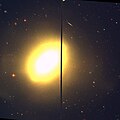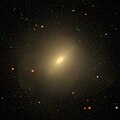NGC 3610
| NGC 3610 | |
|---|---|
NIR) | |
| Other designations | |
| NGC 3610, UGC 6319, LEDA 34566, PGC 34566[5] |
NGC 3610 is an
NGC 3610 is a relatively young elliptical galaxy which has not yet lost its disk.
The unusual amount of blue light emission of NGC 3610, or B–V in the UBV photometric system, suggests recent star formation.[9] The current estimated star formation rate is 0.385±0.375 M☉·yr−1.[4] There is a population of younger globular clusters orbiting the galaxy that is a likely product of the merger. The surviving population of older, metal-rich globular clusters suggests that at least one of the progenitor galaxies had a prominent bulge component.[9]
Gallery
-
NGC 3610 by Hubble Space Telescope
-
NGC 3610 (SDSS DR14)
References
- ^ S2CID 18913331.
- ^ a b c "Results for NGC 252". NASA/IPAC Extragalactic Database. Retrieved 12 February 2017.
- ^ S2CID 250737862.
- ^ .
- ^ "NGC 3610". SIMBAD. Centre de données astronomiques de Strasbourg. Retrieved 12 February 2017.
- ^ a b "A young elliptical". Hubble Space Telescope. Retrieved 16 December 2016.
- ^ Seligman, Courtney. "NGC 3610 (= PGC 34566)". cseligman. Retrieved 12 February 2017.
- ^ .
- ^ doi:10.1086/425884.
Further reading
- Bassino, Lilia P.; Caso, Juan P. (April 2017). "The merger remnant NGC 3610 and its globular cluster system: a large-scale study". Monthly Notices of the Royal Astronomical Society. 466 (4): 4259–4271. .
- Goudfrooij, Paul; et al. (June 2007). "Dynamical Evolution of Globular Cluster Systems Formed in Galaxy Mergers: Deep Hubble Space Telescope Advanced Camera for Surveys Imaging of Old and Intermediate-Age Globular Clusters in NGC 3610". The Astronomical Journal. 133 (6): 2737–2751. doi:10.1086/516634.
- Strader, Jay; et al. (January 2004). "Revisiting the Globular Cluster System of the Merger Remnant Elliptical Galaxy NGC 3610". The Astronomical Journal. 127 (1): 295–301. doi:10.1086/380614.
- Strader, Jay; et al. (February 2003). "Keck Spectroscopy of Globular Clusters in the Elliptical Galaxy NGC 3610". The Astronomical Journal. 125 (2): 626–633. doi:10.1086/346086.
- Whitmore, Bradley C.; et al. (July 2002). "The Luminosity Functions of Old and Intermediate-Age Globular Clusters in NGC 3610". The Astronomical Journal. 124 (1): 147–157. doi:10.1086/340808.
- Fabbiano, G.; Schweizer, Francois (July 1995). "ROSAT PSPC Observations of Two Dynamically Young Elliptical Galaxies: NGC 4125 and NGC 3610". Astrophysical Journal. 447: 572. doi:10.1086/175900.
- Scorza, C.; Bender, R. (August 1990). "A disk in the elliptical galaxy NGC 3610". Astronomy and Astrophysics. 235: 49. Bibcode:1990A&A...235...49S.
External links
 Media related to NGC 3610 at Wikimedia Commons
Media related to NGC 3610 at Wikimedia Commons


